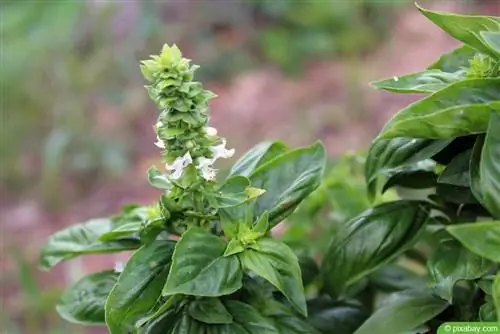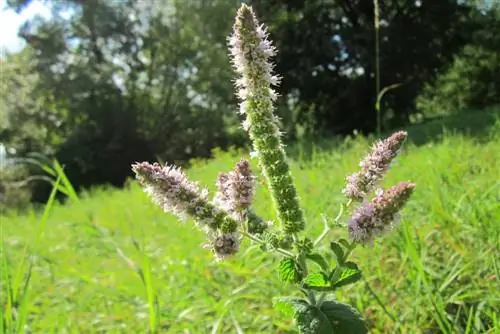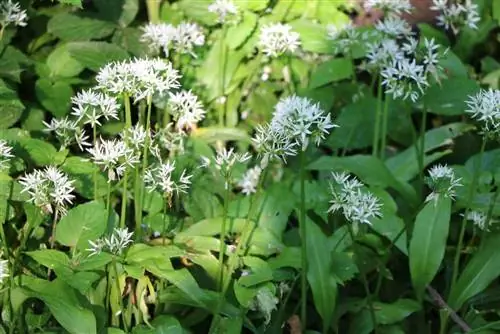- Author admin [email protected].
- Public 2023-12-17 03:39.
- Last modified 2025-01-24 12:45.
Basil is one of our favorite herbs in the kitchen. As fresh and aromatic as possible. That's why this herb is often sown in the garden or kept in pots on the windowsill. At some point in the summer, new leaves stop sprouting. All the power then goes into flower formation. This also has an impact on the flavor of the leaves.
Annual flowering period
Basil plants can be cultivated as annuals or perennials, depending on the variety. However, in our latitudes, surviving the winter is only possible in frost-free rooms. Growth can pick up speed again in spring. Every year the plant also strives towards flowering. The seed formation ultimately ensures the preservation of the species.
- around July the time will come
- the first flower buds are emerging
- each at the tips of the stems
- this uses up all of the plant's energy reserves
- that's why it no longer produces new leaves
But even if the herb is only blooming now, there are still enough green leaves on the shoots. Are they still an enrichment for our dishes? Or is the harvest over with the first flowering?
The aroma fades away
If you harvest the green leaves of basil during or after flowering, you will notice a noticeable change in taste. They are no longer as intensely loaded with flavors as we are used to. That can be disappointing. There is also a bitter taste. But the leaves are by no means harmful or even poisonous, as is sometimes claimed. They remain edible.
- Aroma intensity decreases
- but the typical taste is still noticeable
- In addition, more bitter substances develop
- Leaves are therefore less suitable for raw consumption
- However, they lose their bitterness when cooked
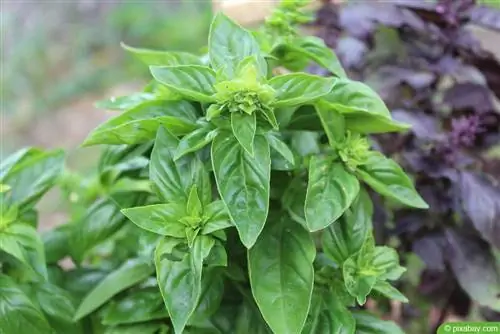
The loss of flavor is inevitable because all the plant's energy is focused on flowering. Meanwhile, aroma formation is neglected.
Prevent flowering
It is not impossible to maintain the typical flavor of the leaves beyond July. However, it is not enough to cut off the already flowering tips. Even flowering must be consistently prevented. But most cooks pluck individual leaves from the stems when necessary. This approach is not recommended. Sooner or later the flower buds will appear on the remaining shoot tips. If too many leaves are plucked from the stems, they will not have enough strength to survive and they will die completely. It makes much more sense to harvest the herb as follows:
- prevent flowering by removing the tip
- hence cutting whole shoots
- the cut piece should be at least 5 cm long
- but leave a remainder with at least one pair of leaves
- New basil sprouts from the leaf axils
- this method of harvesting promotes a bushy shape
- the harvest quantity is increased
- the harvest season is extended until frost
Tip:
If the basil is developing so well that you cannot use all the shoots promptly, you should still harvest them before they bloom. You don't have to throw away what you cut off. This culinary herb freezes well.
Use flowers for culinary purposes
When the basil is blooming, the small flowers do not necessarily have to be viewed exclusively as a disruptive factor. They areedibleThat's why you can make something tasty out of them. Dried basil flowers make a deliciousTea
Basil Vinegar Recipe:
- harvest about a handful of flowers
- pick an additional 12-15 leaves
- add to 200 ml white wine vinegar
- let it steep for a month
- then strain and discard the basil parts
- the vinegar can be used for salad dressings
- or to season other dishes
Basil flowers as insect food
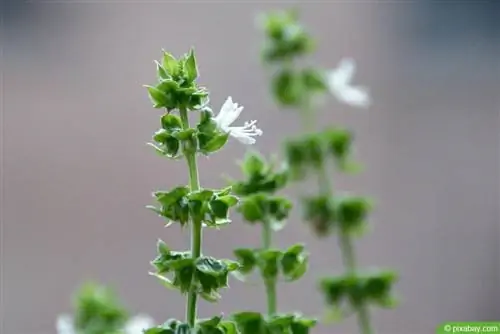
With a basil that is already fully blooming, the loss of aroma from the leaves can no longer be stopped. Cutting the flowers is no longer worth it unless they are used in the kitchen. Otherwise, just leave them alone. Flowering basil in the garden is an insect magnet and is to be welcomed for this reason alone. If you have sown several specimens in the spring, you can use two-glass plants without any loss of harvest. While you prevent all flower buds from some plants, other specimens are allowed to keep their white or, depending on the species, other colored flowers and thus serve as food for bees and the like.
Tip:
However, if you do not want to sow yourself, you must cut off the spent flower remains in good time before seeds form.
Collecting seeds
Basil does not survive local winters if it is left outside in the bed. That's why it is sown anew every year or bought as a young plant. But neither seeds nor young plants have to be bought from retailers for money. If you let a few shoots grow without cutting them, the following flowers will develop into mature seeds.
- cut the dry inflorescences first
- grate over a bowl
- Sift out seeds, remove plant residues
- store dark, cool and dry until spring
You can get new plants for free in the spring from the seeds obtained in this way. But you can also forego harvesting seeds and instead hope for self-sowing. Most of the time it will happen.

